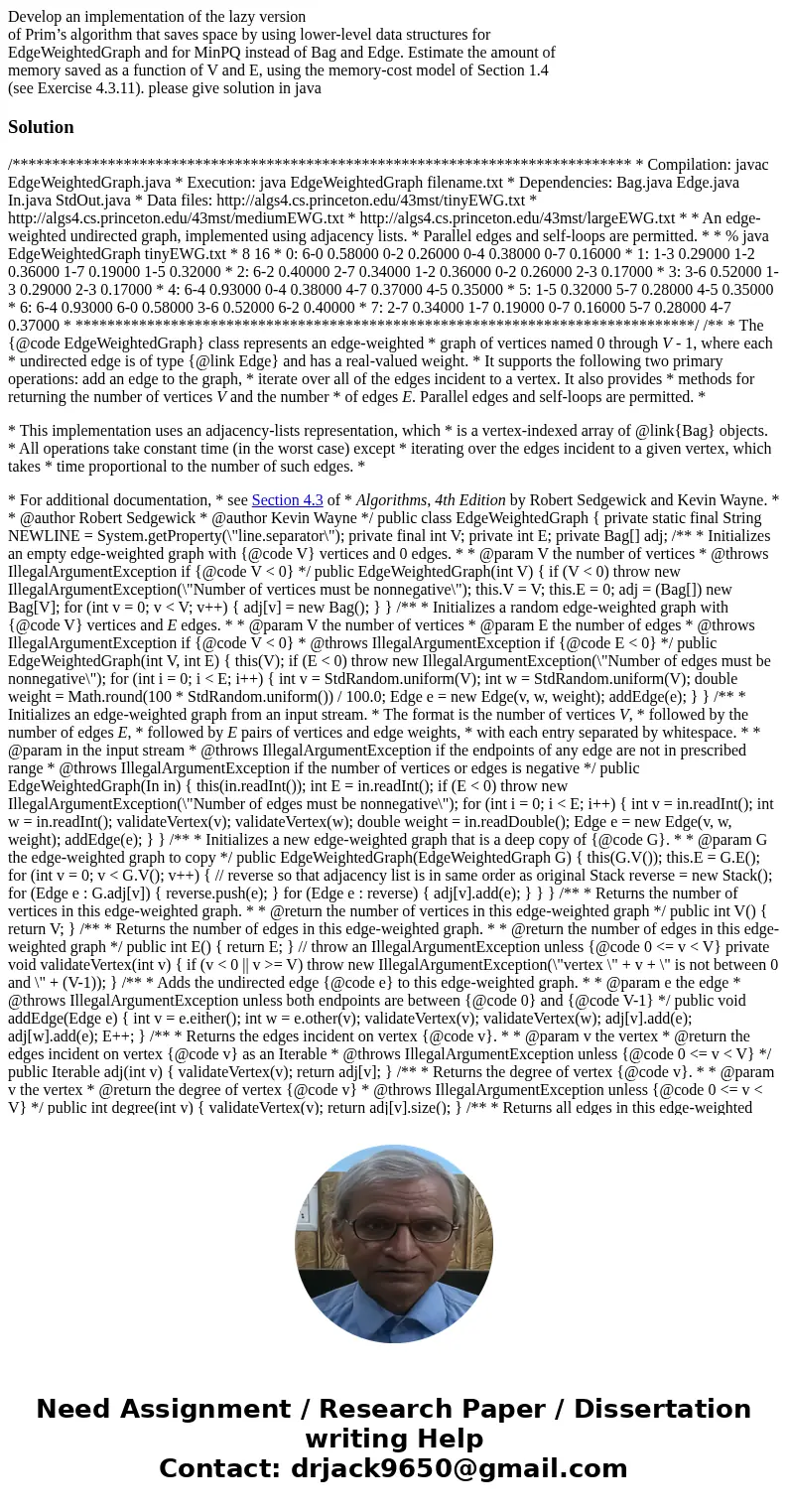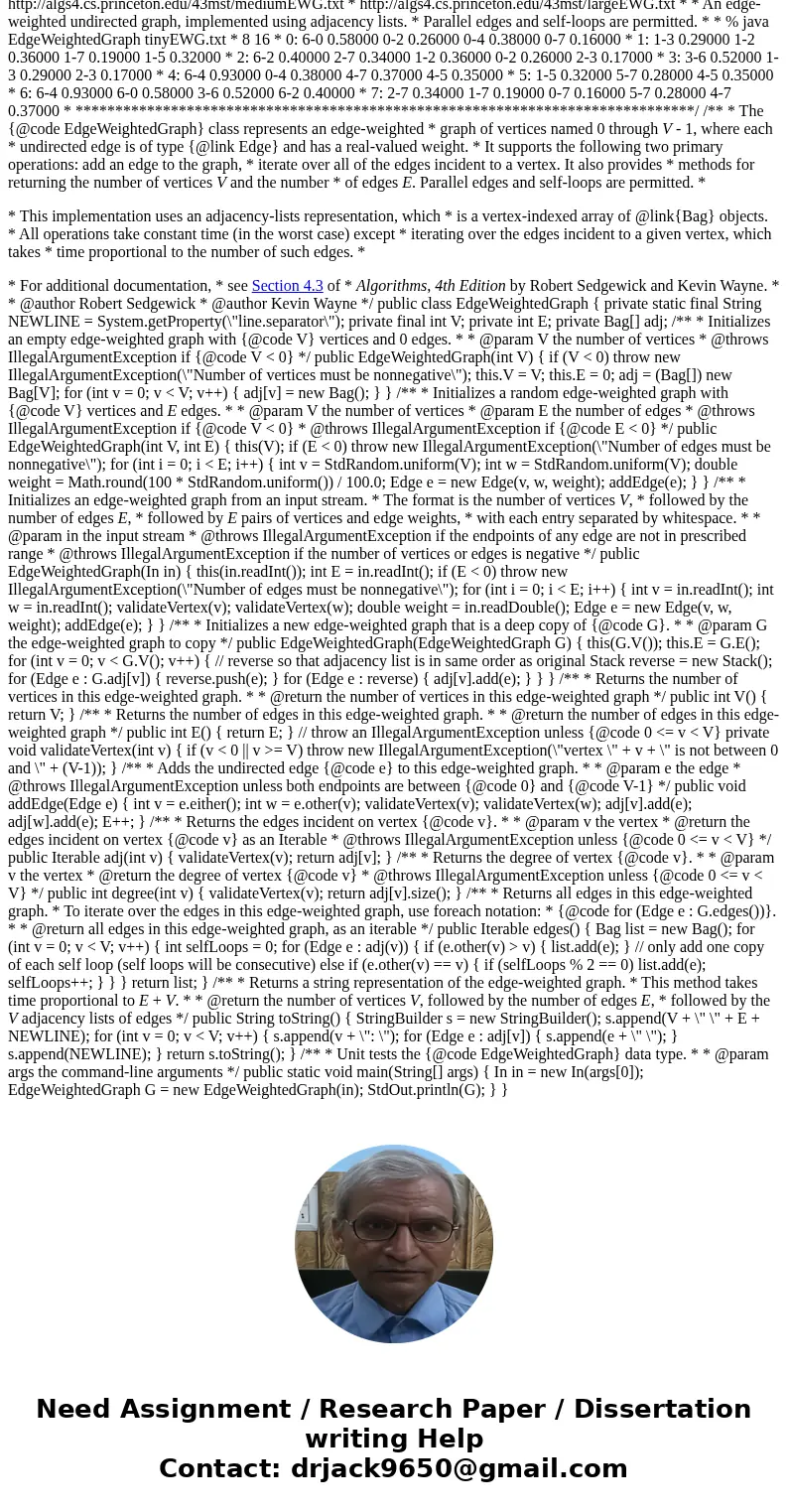Develop an implementation of the lazy version
of Prim’s algorithm that saves space by using lower-level data structures for
EdgeWeightedGraph and for MinPQ instead of Bag and Edge. Estimate the amount of
memory saved as a function of V and E, using the memory-cost model of Section 1.4
(see Exercise 4.3.11). please give solution in java
/****************************************************************************** * Compilation: javac EdgeWeightedGraph.java * Execution: java EdgeWeightedGraph filename.txt * Dependencies: Bag.java Edge.java In.java StdOut.java * Data files: http://algs4.cs.princeton.edu/43mst/tinyEWG.txt * http://algs4.cs.princeton.edu/43mst/mediumEWG.txt * http://algs4.cs.princeton.edu/43mst/largeEWG.txt * * An edge-weighted undirected graph, implemented using adjacency lists. * Parallel edges and self-loops are permitted. * * % java EdgeWeightedGraph tinyEWG.txt * 8 16 * 0: 6-0 0.58000 0-2 0.26000 0-4 0.38000 0-7 0.16000 * 1: 1-3 0.29000 1-2 0.36000 1-7 0.19000 1-5 0.32000 * 2: 6-2 0.40000 2-7 0.34000 1-2 0.36000 0-2 0.26000 2-3 0.17000 * 3: 3-6 0.52000 1-3 0.29000 2-3 0.17000 * 4: 6-4 0.93000 0-4 0.38000 4-7 0.37000 4-5 0.35000 * 5: 1-5 0.32000 5-7 0.28000 4-5 0.35000 * 6: 6-4 0.93000 6-0 0.58000 3-6 0.52000 6-2 0.40000 * 7: 2-7 0.34000 1-7 0.19000 0-7 0.16000 5-7 0.28000 4-7 0.37000 * ******************************************************************************/ /** * The {@code EdgeWeightedGraph} class represents an edge-weighted * graph of vertices named 0 through
V - 1, where each * undirected edge is of type {@link Edge} and has a real-valued weight. * It supports the following two primary operations: add an edge to the graph, * iterate over all of the edges incident to a vertex. It also provides * methods for returning the number of vertices
V and the number * of edges
E. Parallel edges and self-loops are permitted. *
* This implementation uses an adjacency-lists representation, which * is a vertex-indexed array of @link{Bag} objects. * All operations take constant time (in the worst case) except * iterating over the edges incident to a given vertex, which takes * time proportional to the number of such edges. *
* For additional documentation, * see Section 4.3 of * Algorithms, 4th Edition by Robert Sedgewick and Kevin Wayne. * * @author Robert Sedgewick * @author Kevin Wayne */ public class EdgeWeightedGraph { private static final String NEWLINE = System.getProperty(\"line.separator\"); private final int V; private int E; private Bag[] adj; /** * Initializes an empty edge-weighted graph with {@code V} vertices and 0 edges. * * @param V the number of vertices * @throws IllegalArgumentException if {@code V < 0} */ public EdgeWeightedGraph(int V) { if (V < 0) throw new IllegalArgumentException(\"Number of vertices must be nonnegative\"); this.V = V; this.E = 0; adj = (Bag[]) new Bag[V]; for (int v = 0; v < V; v++) { adj[v] = new Bag(); } } /** * Initializes a random edge-weighted graph with {@code V} vertices and E edges. * * @param V the number of vertices * @param E the number of edges * @throws IllegalArgumentException if {@code V < 0} * @throws IllegalArgumentException if {@code E < 0} */ public EdgeWeightedGraph(int V, int E) { this(V); if (E < 0) throw new IllegalArgumentException(\"Number of edges must be nonnegative\"); for (int i = 0; i < E; i++) { int v = StdRandom.uniform(V); int w = StdRandom.uniform(V); double weight = Math.round(100 * StdRandom.uniform()) / 100.0; Edge e = new Edge(v, w, weight); addEdge(e); } } /** * Initializes an edge-weighted graph from an input stream. * The format is the number of vertices V, * followed by the number of edges E, * followed by E pairs of vertices and edge weights, * with each entry separated by whitespace. * * @param in the input stream * @throws IllegalArgumentException if the endpoints of any edge are not in prescribed range * @throws IllegalArgumentException if the number of vertices or edges is negative */ public EdgeWeightedGraph(In in) { this(in.readInt()); int E = in.readInt(); if (E < 0) throw new IllegalArgumentException(\"Number of edges must be nonnegative\"); for (int i = 0; i < E; i++) { int v = in.readInt(); int w = in.readInt(); validateVertex(v); validateVertex(w); double weight = in.readDouble(); Edge e = new Edge(v, w, weight); addEdge(e); } } /** * Initializes a new edge-weighted graph that is a deep copy of {@code G}. * * @param G the edge-weighted graph to copy */ public EdgeWeightedGraph(EdgeWeightedGraph G) { this(G.V()); this.E = G.E(); for (int v = 0; v < G.V(); v++) { // reverse so that adjacency list is in same order as original Stack reverse = new Stack(); for (Edge e : G.adj[v]) { reverse.push(e); } for (Edge e : reverse) { adj[v].add(e); } } } /** * Returns the number of vertices in this edge-weighted graph. * * @return the number of vertices in this edge-weighted graph */ public int V() { return V; } /** * Returns the number of edges in this edge-weighted graph. * * @return the number of edges in this edge-weighted graph */ public int E() { return E; } // throw an IllegalArgumentException unless {@code 0 <= v < V} private void validateVertex(int v) { if (v < 0 || v >= V) throw new IllegalArgumentException(\"vertex \" + v + \" is not between 0 and \" + (V-1)); } /** * Adds the undirected edge {@code e} to this edge-weighted graph. * * @param e the edge * @throws IllegalArgumentException unless both endpoints are between {@code 0} and {@code V-1} */ public void addEdge(Edge e) { int v = e.either(); int w = e.other(v); validateVertex(v); validateVertex(w); adj[v].add(e); adj[w].add(e); E++; } /** * Returns the edges incident on vertex {@code v}. * * @param v the vertex * @return the edges incident on vertex {@code v} as an Iterable * @throws IllegalArgumentException unless {@code 0 <= v < V} */ public Iterable adj(int v) { validateVertex(v); return adj[v]; } /** * Returns the degree of vertex {@code v}. * * @param v the vertex * @return the degree of vertex {@code v} * @throws IllegalArgumentException unless {@code 0 <= v < V} */ public int degree(int v) { validateVertex(v); return adj[v].size(); } /** * Returns all edges in this edge-weighted graph. * To iterate over the edges in this edge-weighted graph, use foreach notation: * {@code for (Edge e : G.edges())}. * * @return all edges in this edge-weighted graph, as an iterable */ public Iterable edges() { Bag list = new Bag(); for (int v = 0; v < V; v++) { int selfLoops = 0; for (Edge e : adj(v)) { if (e.other(v) > v) { list.add(e); } // only add one copy of each self loop (self loops will be consecutive) else if (e.other(v) == v) { if (selfLoops % 2 == 0) list.add(e); selfLoops++; } } } return list; } /** * Returns a string representation of the edge-weighted graph. * This method takes time proportional to E + V. * * @return the number of vertices V, followed by the number of edges E, * followed by the V adjacency lists of edges */ public String toString() { StringBuilder s = new StringBuilder(); s.append(V + \" \" + E + NEWLINE); for (int v = 0; v < V; v++) { s.append(v + \": \"); for (Edge e : adj[v]) { s.append(e + \" \"); } s.append(NEWLINE); } return s.toString(); } /** * Unit tests the {@code EdgeWeightedGraph} data type. * * @param args the command-line arguments */ public static void main(String[] args) { In in = new In(args[0]); EdgeWeightedGraph G = new EdgeWeightedGraph(in); StdOut.println(G); } }


 Homework Sourse
Homework Sourse